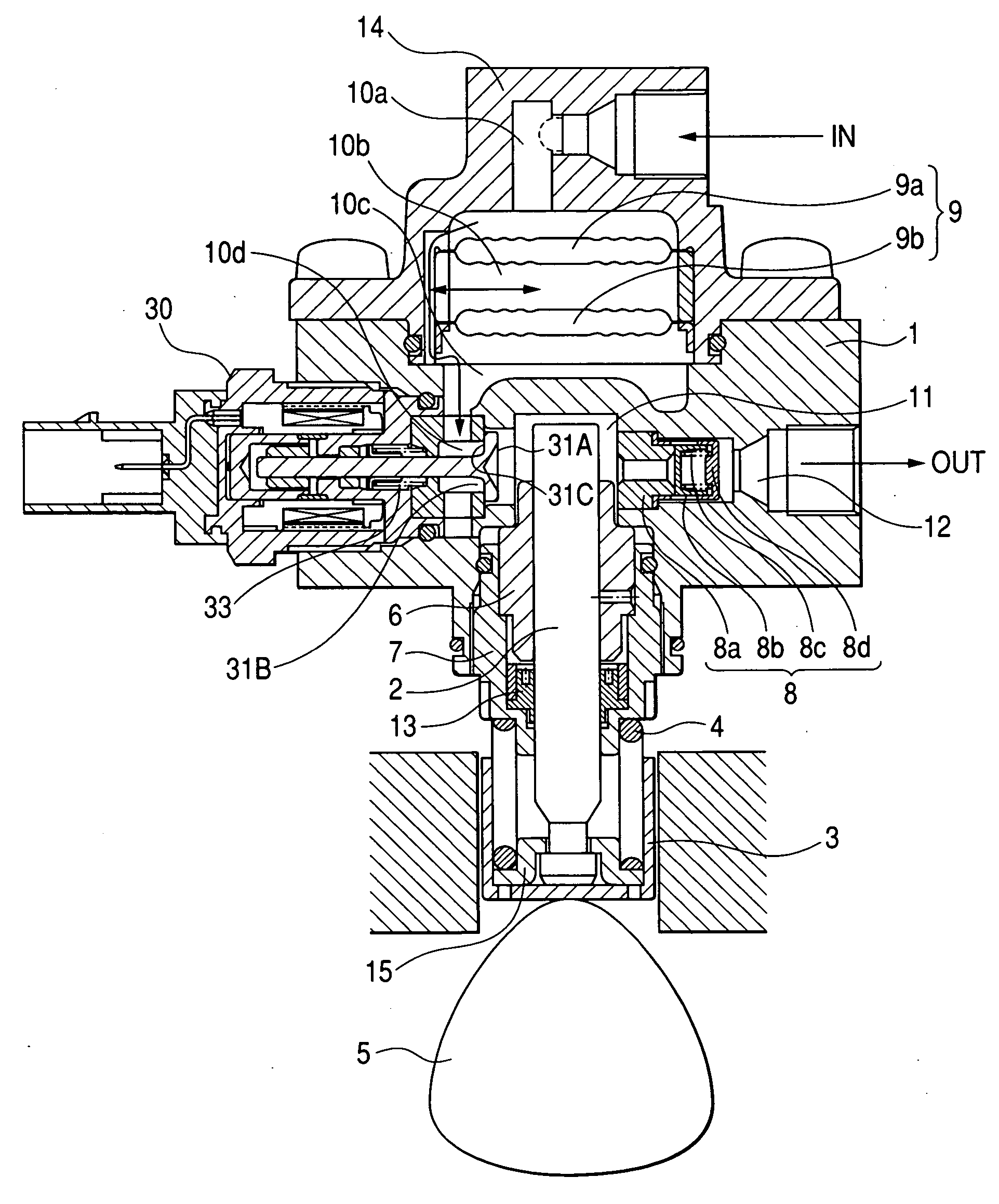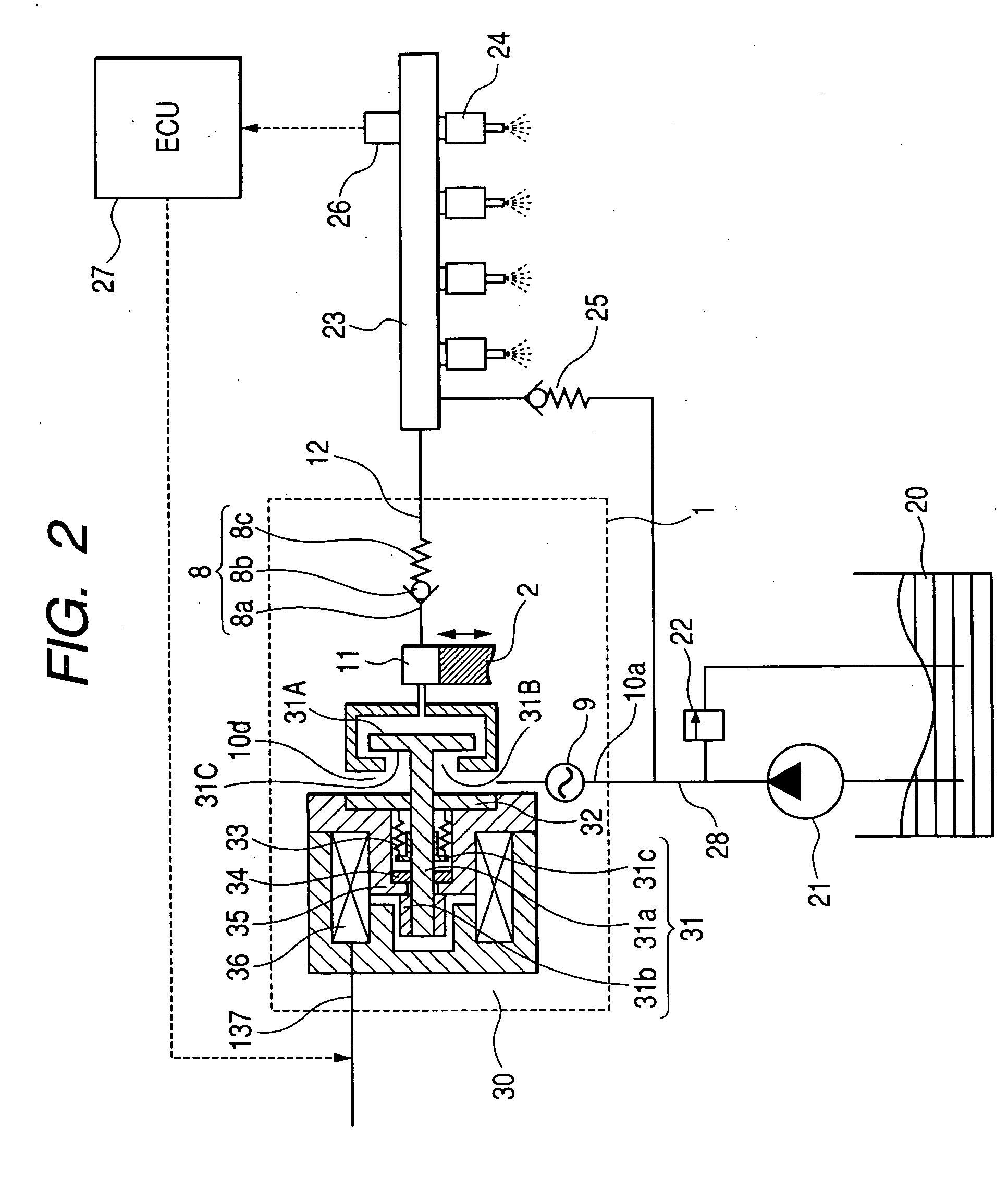Electromagnetic drive mechanism and a high-pressure fuel supply pump
a drive mechanism and drive shaft technology, applied in the direction of fuel injection pumps, electric control, machines/engines, etc., can solve the problems of increasing configuration costs and creating individual differences, and achieve the effect of increasing costs
- Summary
- Abstract
- Description
- Claims
- Application Information
AI Technical Summary
Benefits of technology
Problems solved by technology
Method used
Image
Examples
embodiment 1
[0025]FIG. 1 is a longitudinal sectional view of an entire high-pressure fuel supply pump of a first embodiment according to the present invention.
[0026]FIG. 2 is a schematic system diagram of a fuel supply system of an internal combustion engine.
[0027] A damper cover 14 including a pressure pulsation damping mechanism 9 for damping the fuel pressure pulsation is mounted to the pump body 1. The damper cover 14 has a fuel intake port 10a.
[0028] An intake passage 10 comprises fuel intake ports 10a, 10b, 10c and 10d, and a pressure pulsation damping mechanism 9 for damping the fuel pressure pulsation is located in the middle of the passage.
[0029] A fuel discharge port 12 is provided in the pump body 1, and a pressure chamber 11 for pressurizing fuel is provided in the middle of the fuel passage which extends from the fuel intake port 10ato the fuel discharge port 12.
[0030] An electromagnetic intake valve 30 is provided at the inlet of the pressure chamber 11. The electromagnetic i...
embodiment 2
[0067] Next, a second embodiment of the present invention will be described with reference to FIGS. 7 and 8.
[0068]FIG. 7 is an enlarged view of the inside of the pump. What is different from FIG. 3 and FIG. 4 is that the intake valve 31 is open but is not fully open, and does not come in contact with core 35 which is a restricting member.
[0069]FIG. 8 shows the operation of the pump. What is different from FIG. 5 is that the intake valve 31 is open but is not fully open until halfway of the intake process, and does not come in contact with core 35 which is a restricting member.
[0070] When the plunger 2 is functioning in the intake process as the result of the rotation of the cam 5, the volume of the pressure chamber 11 increases and the fuel pressure decreases. If the fuel pressure of the pressure chamber 11 becomes lower than the pressure of the intake passage 10d, a valve-opening force is generated by fluid differential pressure of fuel in the intake valve 31.
[0071] Due to the ...
embodiment 3
[0075] Next, a third embodiment of the present invention will be described with reference to FIG. 9.
[0076]FIG. 9 shows the operation of the pump. What is different from FIG. 8 is that generated current is restricted.
[0077] When the plunger 2 is functioning in the intake process as the result of the rotation of the cam 5, the volume of the pressure chamber 11 increases and the fuel pressure decreases. If the fuel pressure of the pressure chamber 11 becomes lower than the pressure of the intake passage 10d, a valve-opening force is generated by fluid differential pressure of fuel in the intake valve 31.
[0078] Due to the valve-opening force, the valve overcomes a biasing force of the intake valve spring 33 and opens. At this time, as shown in FIG. 5, it is possible to determine the necessary biasing force of the intake valve spring 33 so that the valve fully opens due to the fluid differential pressure, and comes in contact with core 35 which is a restricting member. Furthermore, it...
PUM
 Login to View More
Login to View More Abstract
Description
Claims
Application Information
 Login to View More
Login to View More - R&D
- Intellectual Property
- Life Sciences
- Materials
- Tech Scout
- Unparalleled Data Quality
- Higher Quality Content
- 60% Fewer Hallucinations
Browse by: Latest US Patents, China's latest patents, Technical Efficacy Thesaurus, Application Domain, Technology Topic, Popular Technical Reports.
© 2025 PatSnap. All rights reserved.Legal|Privacy policy|Modern Slavery Act Transparency Statement|Sitemap|About US| Contact US: help@patsnap.com



